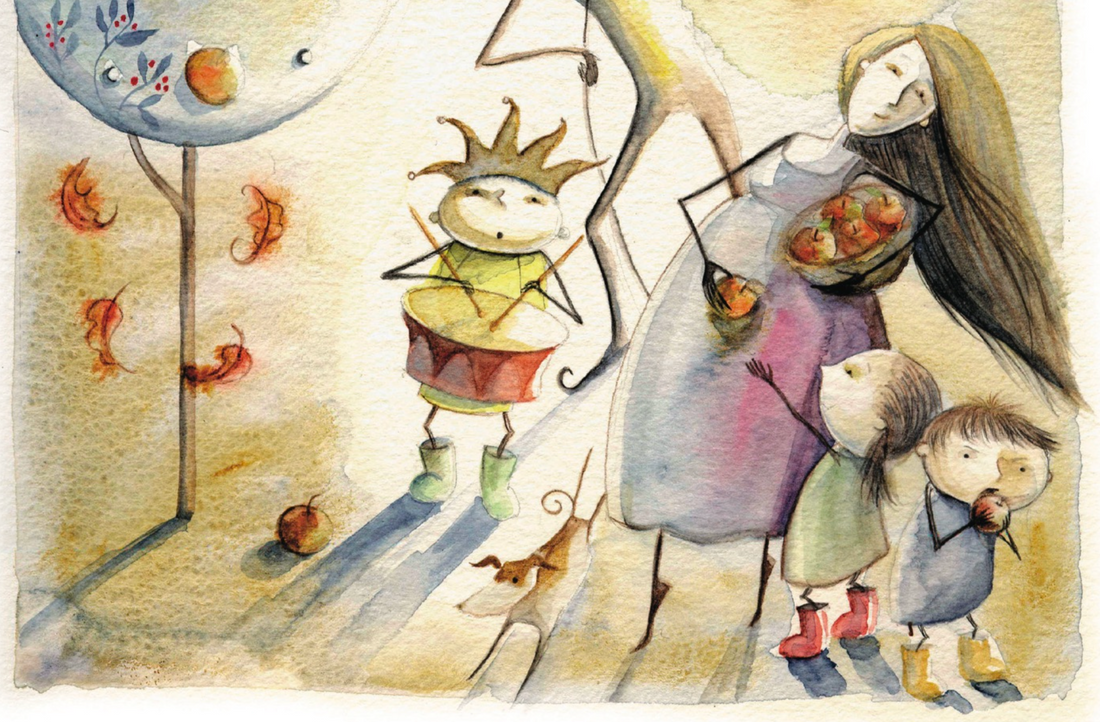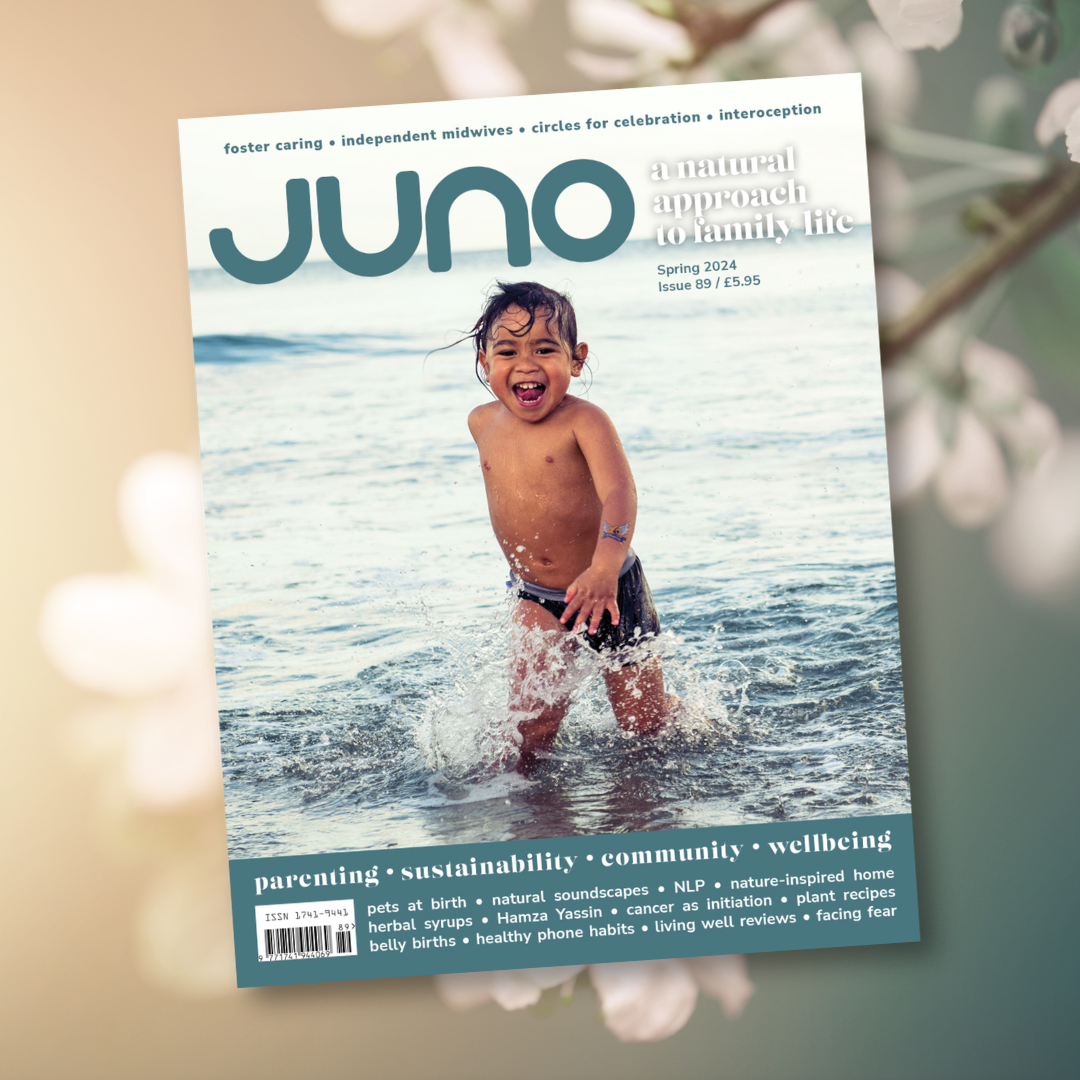As a celebrant, I find it greatly rewarding to encourage people to create ceremonies that are relevant and satisfying for them. I strongly believe that rituals and ceremonies to mark rites of passage and life events are of vital importance to us, both culturally and as individuals. Underpinning and interwoven with these irregular events is a rhythmic, seasonal calendar of festivals, which I celebrate with family and friends.
I started developing these festivals for myself when my partner’s job necessitated a move away from the Snowdonia Steiner School. I realised that in order to stay in touch with the cycle of the year in the way Waldorf education encourages I would have to embrace the responsibility of creating festivals at home rather than just going along to those provided by the school community. I have since also been drawn into following the Celtic Wheel of the Year. Creating my own celebrations has been a fulfilling, creative and empowering process.
Wherever we live, acknowledging the Earth’s cycles gives us reassurance that in spite of human experience and activities the world does indeed still turn. And in areas of the world that have distinct seasons, winter’s rest, spring’s renewal, summer’s blossoming and autumn’s fruiting are a powerful constancy. If we tune into the particular energy of the time of year we can be in harmony with Nature’s rhythms. Many of us do more nesting and resting in winter, when the energy is inward-looking and reflective, but the tremendous growth surge in spring inspires frenetic outside activities to make the most of longer days. The festivals enhance those tendencies that are already there. They give us the chance to stop for a moment in our busy lives, to notice where we are and why, and to reflect as well as appreciate.
As soon as I begin preparations for a festival there is a tangible response from my children. They recognise the props, materials and decorations and they are interested and reassured that they know where we are in the year: they know what to anticipate and how things will happen. It’s interesting and rewarding to see the children developing as the years progress and to observe the changes in their response to the festivals. It was poignant last winter to see the boisterous boys, who previously struggled to ‘walk the Advent spiral’ slowly, transformed into the epitome of reverence and calm.
The eldest of my five children is fifteen years older than the youngest, yet the older ones still play an active role at festival time. As they intuitively outgrow the need to be a part of an activity or ritual, and display an apparent adolescent disinterest, there is still a willingness to be included and they develop new roles: perhaps as the person who leads the procession; the one who lights a hundred lanterns; the guardian of the bonfire; the drummer; or a helper for the toddlers. The young children readily aspire to follow the example the older ones set: to walk slowly, to sit quietly, to sing along with the song. The adolescents are a huge support to me, and the other adults involved also welcome and appreciate their continued inclusion. I feel that adolescents spend so much time feeling confused and frustrated at being in between childhood and adulthood that it’s really positive for them at festival time to have a clear role and one that neither children nor adults present could fulfil as well. My fifteen-year-old daughter takes her role of handing out the ‘candle apples’ at Advent very seriously, to the extent that she even fishes out a suitable, modest, noncleavage-showing top for the occasion! My thirteen-year-old son has the little children riveted by stories (with props) he has invented for Midwinter.
I find that the framework of regular gatherings gives us all security and stability, providing a foundation for developing larger events which stands us in good stead when needing to deal with an unexpected major event such as a sudden death. We are able to draw on the familiarity of certain ‘rituals’ or actions we have used in lighter circumstances, to comfort and ground us at times of distress. They help with the beginnings, transitions and endings that life presents.
Here are some ideas that I find useful in making festivals part of my life:
Research
Follow your own interest and intuition and choose a day to mark. Do a little exploration to find out about different interpretations and traditions. What is special to this time of year? What activities would be appropriate? How could you express the essence of what the celebration is about? Choose elements that mean the most to you, and the festival will feel more authentic for everyone, especially the children. Books by Glennie Kindred and Steiner-related publications have been my greatest inspiration so far.
Intention
I feel it’s essential to establish the intention of the celebration for yourself even if it’s not explicit to anyone else. Beltane, for example, is about celebrating fertility and rampant potency, but with the children I talk about celebrating the green ‘life force’ and the union of opposites. Decide how to get the intention across to the children by means of an introduction, by chatting as you are creating something for the ceremony or through participation in a symbolic gesture. If you are extending the celebration to children other than your own, it is sometimes helpful to brief parents on the mood you wish to create so that you have their support for it; but I suggest you refrain from explaining to the children and allow them to respond intuitively to what’s happening.
Keep it simple
Work within the limitations of available time, energy, location, finance, knowledge and the weather! Over time no doubt you will expand your ideas, try new things and refine the details, but it is better initially to be realistic so that things will run smoothly.
Preparations and ‘stage management’
Decide what to include, and what needs to be done to set everything in place. Participation is important so that people feel that they are included and are not simply observers. A successful basic structure might include a creative activity on arrival, a procession, a circle, songs or poetry, a quiet time for giving thanks, a symbolic ritual to honour the elements, conclusion and feast. The possibilities are endless but don’t feel the need to include everything on every occasion! Enlist help and delegate practical tasks as much as possible. Give people specific jobs such as preparing snacks, ‘meeting and greeting’ and clearing up after the ceremony so that you are free to focus on the main purpose. Prepare parents in advance for special requests for dressing up such as wearing cloaks or a special colour to enhance the atmosphere. Run through the order in as much detail as possible for yourself, and brief your helpers for support. Assistance with getting everyone into a circle or tying bells onto wrists, for example, is invaluable. The more you prepare and plan the details, the more the festival celebration will appear to flow effortlessly. A strategy for drawing things to a close might also be important: for example, subtly turning up the lights so that everyone leaves at the same time.
Rituals
Rituals can be as simple as lighting a candle to begin a ceremony, cutting open an apple to wonder at the star inside, sharing bread, or placing something on an ‘altar’. My children took turns to place their little handmade nests on a mossy bank at Spring Equinox. If it seems appropriate, explain the symbolism and how it links to the general theme of your intention and of what you are seeking to acknowledge. Repetition of core rituals can be profound and magical. Children readily engage in the simplicity of sprinkling a pinch of silver glitter on white silk to represent the frost outside. Even though it’s ‘only glitter’ and they may have done this before, the stillness of the moment as they watch each other take turns takes on a special quality. If I want to try something new I have to be careful to preserve enough of the old way of doing things for the children to identify with. It seems to work best to have some things repeated year after year, with the flexibility to include something new that is appropriate.
Creative activities
Be really organised with the materials beforehand, however simple your project. Set everything out on a table or have it to hand in a basket. Experiment in advance. Enlist your adolescent helpers (they are glad of the excuse to get involved, really!) Some examples:
- ‘Green Man’ masks and flower garlands at Beltane
- Crowns at Midwinter (recognising the old tradition of welcoming the return of the ‘sun king’ to power)
- Candle dipping at Imbolc (linked to the Christian tradition of candle blessing – Candlemas)
- Paper lantern making in a separate session prior to a lantern walk at Martinmas
- Origami boats for New Year (practise your technique!)
- Corn dollies at Lammas
Feast
Actually, this might only be a snack! Vary the food to suit the occasion and season of the festival: bread and soup after an autumn lantern walk, star biscuits and hot chocolate for the Advent spiral, a picnic at Lammas, home-made apple juice on Apple Day, pomegranate at Midwinter, pumpkin pie at Hallowe’en.
Over the years I have gradually added to our repertoire, using the Celtic Wheel as my reference but including other interpretations where it feels relevant. I don’t seek to present the children with any specific beliefs but rather introduce ‘what some people believe’ or have believed in the past and relate it to Nature and the activities I have chosen to include. I like to incorporate elements from different beliefs and allow people to interpret things for themselves.
I frequently discover that I have gained just as much from a ceremony, or more, than the children I have prepared it for, and I readily acknowledge that I may well be doing all this for my own ‘inner child’. I feel comfortable with that, for everything I do for myself will inevitably benefit my children.
My experience is that everyone invited to our festivals responds positively and that when the intention is clear the ceremony that unfolds is personal, pertinent, uplifting, meaningful and creative and celebrates life in every way.
____
Mel Gard lives in Grizedale Forest, Cumbria and weaves together the roles of Mothering and being a Celebrant, Doula and Forest Tutor. She is currently seeking a sustainable rural community in which to live and work in the future.
Illustration by Veronica Petrie
____
First published in Issue 16 of JUNO. Accurate at the time this issue went to print.



